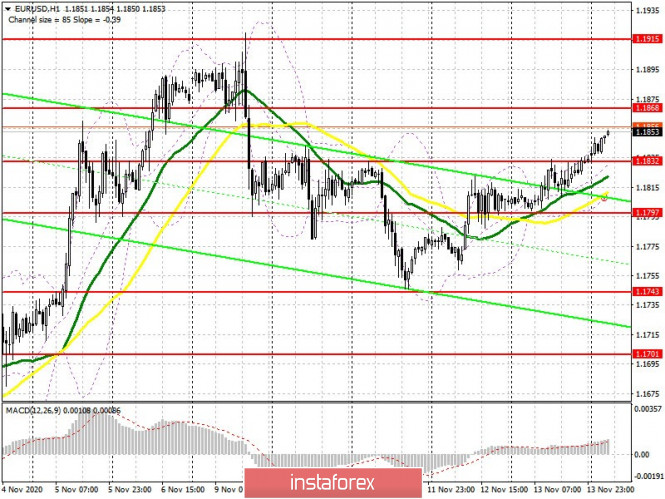To open long positions on EUR/USD, you need:
Although we did not wait for some sort of market-entry signal last Friday, buyers of the euro still managed to seize the moment and strengthened their positions against the US dollar after the release of weak fundamental reports. The report on the sharp decline in consumer sentiment in the United States surprised with its numbers. This is primarily due to the lack of a compromise between Republicans and Democrats on a new package of measures to help the economy and the Americans, as well as because of the new wave of the coronavirus pandemic, which calls for measures of social distancing and isolation. The 5-minute chart clearly shows that there were no entry points to the market, since we did not reach any of the levels.

From a technical point of view, not much has changed either, but there are some changes. There is a new support at 1.1832, and buyers will focus on this particular level in the first half of the day. If the euro bulls manage to protect support at 1.1832, then forming a false breakout there will be a good entry point into long positions, in hopes for the pair to reach the resistance area of 1.1868, which is where the pair might temporarily stop growing. The next target will be the monthly high of 1.1915, where I recommend taking profits. No particularly important fundamental reports for the day, so if bulls are not active in the 1.1832 area, then it is possible for EUR/USD to return under this range. In this case, buyers will focus on protecting support at 1.1797 in the first half of the day. However, you can open long positions from it on the first test, based on a correction of 15-20 points within the day. A larger reversal in favor of buyers will occur if they manage to form a false breakout at 1.1743.
To open short positions on EUR/USD, you need:
The initial task of sellers is to return to the 1.1832 level, which appeared last Friday afternoon. Settling below 1.1832 and testing it from the bottom up produces a more convenient entry point for short positions, in hopes to bring back the downward trend. In this case, the nearest target of the bears will be the low of 1.1797. Testing this level will only indicate that the pair is stuck in a horizontal channel. Going beyond and settling below this range will lead EUR/USD to the lower border of the horizontal channel at 1.1743, where I recommend taking profit. Going beyond this area will increase the pressure on the pair and quickly pull it down to the low of 1.1701, which will indicate the resumption of a new bearish trend. If the bulls are stronger and continue to push the pair up following European Central Bank President Christine Lagarde's speech, then it is best not to rush to sell, and wait for the update of the larger resistance of 1.1868. However, you can only sell from this level if a false breakout appears there. I recommend opening short positions on EUR/USD immediately for a rebound, but only from the monthly high of 1.1915, based on a correction of 15-20 points within the day.

Let me remind you that the Commitment of Traders (COT) report for November 3 showed a reduction in long positions and an increase in short positions. Despite this, buyers of risky assets still believe that the bull market will go on, although they prefer to proceed with caution. Thus, long non-commercial positions fell from 217,443 to 208,237, while short non-commercial positions rose from 61,888 to 67,888. The total non-commercial net position fell to 140 349, from 155,555 a week earlier. Take note that the bullish sentiment on the euro remains rather high in the medium term, especially after Joe Biden's victory, who intends to endow the American economy with the next largest monetary aid package worth more than $2 trillion.
Description of indicators
- Moving average (moving average, determines the current trend by smoothing out volatility and noise). Period 50. It is marked in yellow on the chart.
- Moving average (moving average, determines the current trend by smoothing out volatility and noise). Period 30. It is marked in green on the chart.
- MACD indicator (Moving Average Convergence/Divergence — convergence/divergence of moving averages) Quick EMA period 12. Slow EMA period to 26. SMA period 9
- Bollinger Bands (Bollinger Bands). Period 20
- Non-commercial speculative traders, such as individual traders, hedge funds, and large institutions that use the futures market for speculative purposes and meet certain requirements.
- Long non-commercial positions represent the total long open position of non-commercial traders.
- Short non-commercial positions represent the total short open position of non-commercial traders.
- Total non-commercial net position is the difference between short and long positions of non-commercial traders.
